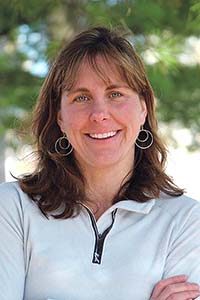MIDDLEBURY — “We’re trying to turn the earth in a different direction.”
That’s how Susan Bruce describes what the state is doing with healthcare reform in Vermont. Bruce directs Addison County’s Blueprint for Health, which coordinates the numerous caregivers that connect the dots outside the doctor’s office.
Bruce says the state’s journey into “uncharted territory” advances three goals: better care, better access to care, and cost savings. The method is simple: “Keep the healthy people healthy by doing preventative work.”
Wrap-around care is the cornerstone of Vermont’s “all payer” experiment, which will incentivize providers to spend more time talking to each other and teaming up to keep individuals and communities healthy, rather than the current fee-for-service system.
“Value-based payment.” “Accountable care.” “All-payer.” There are many names for the new system, which is intended to cover 70 percent of Vermonters by 2022. The goal is simple: Pay doctors based on the health outcomes of their patients, rather than the number of people they see or procedures they perform.
The problem was clear to the powers-that-be on the Green Mountain Care Board. “Our costs were far outpacing inflation and healthcare was becoming less and less affordable,” explains Jessica Holmes, Middlebury College professor and member of the small governor-appointed body that oversees regulation on the state level.

The GMCB, along with the state Agency for Human Services and the Governor’s office, signed the waiver with the Centers for Medicare and Medicaid Services that got the ball rolling on payment reform two years ago.
Why is healthcare so expensive? Many blame the “fee-for-service” model, which compensates doctors based on volume; that is, the more patients they see, the more insurance companies reimburse them.

Carrie Wulfman, Porter Medical Center’s Chief Medical Officer and a longtime primary care physician in Brandon who still sees patients every week, corroborates this analysis: “The only incentive in a fee-for-service world is to see more people, so you hope people are sicker so then you’ll have your appointments filled.”Description: http://www.addisonindependent.com/files/images/Wulfman,%20Carrie(1).jpg
Doctors certainly don’t wish for sick patients, but this is a fair representation of their financial incentives. It’s well known that this structure wastes time and money. In Holmes’ words, “there’s plenty of evidence that the fee-for-service model has led to over-utilization.” She says that between 10 and 30 percent of our healthcare is not cost-effective.
So how do we make healthcare less expensive, all while improving quality? The solution, Holmes says, “is a way of really reimagining how we pay for and deliver healthcare in Vermont.” Private insurance, Medicare and Medicaid are disbursed to providers through one administrative body, formed by providers for providers, called an Accountable Care Organization (ACO).
Health practices join the network and allow the ACO to manage all their insurance reimbursements. Vermont’s ACO is called OneCare Vermont. When your primary care practice has joined the ACO, your medical coverage is billed through OneCare Vermont. Ten of the fourteen hospitals in the state are signed on, along with about 160 other health organizations around the state.
Under the all-payer system, doctors are given a lump sum based on the number of patients they see. They get extra resources to treat patients that are known to have more complex care needs. This is called a capitated system.
With this capitated finance structure, according to Holmes, “(Doctors) are not going to be ordering another test just to generate money: (They will ask), is that test going to actually help improve the quality of my patient’s care?”
If providers meet health outcome goals for their population of patients, as measured by the ACO, doctors can stand to benefit financially, especially if they come in under budget. You heard that right — doctors could get rewarded for delivering less treatment.
Aiming to keep patients out of the office is really the way doctors see their job in the first place.
“The reform goals are goals that I’ve held all throughout my years in medicine,” says Dr. Wulfman. “I don’t want to treat people when they are sick, I want to help them stay well. That’s the fun of it for me.”
As Holmes says, “we want to pay providers to keep people healthy.” That’s what the all-payer system is designed to do.
So far, so good. The past year has seen all Medicaid patients in participating health centers enter the ACO. Medicaid covers about 30 percent of Vermont’s patient population. Holmes says that “by all accounts, we are hearing positive feedback.” Medicare is next, going live on the first of the New Year.
The Green Mountain Care Board is responsible for making sure this transition is accomplishing its goals of cutting costs while improving quality. After all, says Holmes, “an Accountable Care Organization has to be held accountable.”
So how is Addison County’s health system changing in the midst of this overhaul?
For a lot of the healthcare community, business as usual continues — the only difference is that they have more support and more time to do their job the way they want to.
Value-based care brings an increasing focus on the web of caregivers outside of the doctor’s office. The diverse group of organizations that make up the “community care” or “wrap-around care” in Addison County includes Home Health and Hospice, Counseling Services of Addison County, the Parent/Child Center, Turning Point Center, Champlain Valley Office of Economic Opportunity, and Elderly Services.
The all-payer system incentivizes these players to come to the same table to form “care teams” for patients. This is the central activity that will help those who need the most support from the system — and are also receiving the heaviest investment, often without effective results. When these parts of the care network are more united, the system is achieving “integrated care.”
Dr. Wulfman outlines a case study in the Addison Independent’s Dec. 4 Community Forum, where she illustrates the effectiveness of these care teams. She asserts that as Chief Medical Officer, “the main work is about supporting a team of providers, welcoming everyone to the table who can provide coordinated care for a patient.”
The ACO facilitates the expansion of integrated care in key ways. First, it brings all the wrap-around providers onto one records platform called Care Navigator.
On that platform providers can read extensive notes from numerous appointments around the care spectrum that may not appear relevant at first glance, but can in fact make a big difference when evaluating and treating a patient.
OneCare is also supporting care coordination by using analytics to identify “high-risk” patients and alert providers that they may need careful attention. As Dr. Wulfman explains, “we are going to identify the toughest, most complex patients, and focus our coordinated care team work on (them) … the ACO helps us (identify those people) with analytics, through our insurance claims data.”
These high-risk patients, representing more than 1,000 people, make up about 9 percent of Porter Medical Center’s Complex Care Coordination program.
Perhaps the most important way the ACO is supporting integrated care is by hiring people like Angel Bishop. She is a member of the Community Health Team, a part of the Blueprint for Health. The Community Health Team is made up of Care Coordinators like herself, dieticians and mental health professionals who field referrals from primary care doctors.
“(Providers will) send me a referral if they find some socioeconomic issue that the person needs help with, whether it’s food insecurity, transportation (or) they don’t have insurance. They’ll send them my way, and I will get in touch with them.”
Bishop gets about 20 referrals per week, and that caseload of several hundred is growing.
She often follows up with patients on the phone or meets them in person wherever that is convenient for them. It’s important to her to have the flexibility to meet people where they are.
In a typical call or meeting, she is able to help patients apply for public assistance and find their local food shelf or transportation resources. “There is a lot available, but mainly people just don’t know how to access the programs.”
It’s simple, but makes a difference. Patients won’t always be willing or able to take some of these steps on their own. “I think that’s a huge part of care coordination — just connecting those dots for people.”
The essence of this new approach is grounded in a holistic understanding of individual health, beginning with factors such as diet, stress, shelter, and other symptoms of poverty.
As Bishop says, this paradigm shift encourages providers to “look at all of the support systems and not just their medical care alone,” and “trying to address those socioeconomic issues that are contributing to their overall health.”
Dr. Wulfman echoes this sentiment, emphasizing the importance of “helping people get involved in their own care. It’s what they do when they go out of the office that’s a much bigger factor (in their health).”
Besides, Bishop explains, patients might not always agree with their doctors, or they just might not have time for the whole story. “Sometimes I will meet with (a patient) and just try to hear what they have to say and find out what their main concern is, because sometimes their main concern is completely different from what the provider referred them for.”
After meeting with a patient, Bishop feels that she has done her job when “they are feeling like someone who is listening and can really do something to help them. Sometimes people don’t get to spend much time with their doctors … I think sometimes people just want to feel like they are being heard, and their concerns are being heard.”
Bishop observes that cigarettes, food insecurity and transportation are top concerns among her referrals. Many patients are also having difficulty affording crucial diabetes and asthma medication.
Groups of providers like the Community Health Action Team (CHAT) and other sub-groups get together to talk about these issues and work towards collaborative solutions, such as investing in housing.
Care Coordinators like Bishop are mostly paid by grants from the state, but also OneCare Vermont and a little bit from Porter Medical Center’s budget. A short-term goal of Dr. Wulfman’s and OneCare is to provide more support for the work that is connecting the dots across the continuum of care.
According to Bishop, the new changes are creating efficiencies that didn’t exist. “It’s complete wraparound care for the patient and it puts all of their providers in touch with each other so there’s not duplication of services. Things are getting done much more quickly.”
Holmes says Addison County has a lot to be proud of when it comes to integrated care. “Middlebury, in a sense, is a model for the rest of the state for how care is coordinated. Is there room for more care coordination? Absolutely. But the silos here seemed smaller and the willingness and engagement of the providers was huge.”
She also says that Vermont’s journey could set an exciting precedent for other states. “What Vermont is trying to do is the first of its kind,” Holmes says. As a small and collaborative state, Vermont makes a great testing ground for new systems, and is now set to lead the way in healthcare.
“We are for sure on the cutting edge,” Holmes said, add that while she’s optimistic about this experiment, the next five years will certainly be telling.
“I think people are really excited about it,” Bishop concurs, noting that the goals of “breaking down silos of care” appear to be playing out on the ground.
“Now we are really communicating,” Bishop says. “It is definitely accountable care.”
Reprinted with permission from the Addison Independent.
